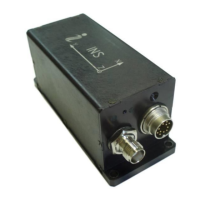INS
GUI User’s Manual
Inertial Labs, Inc
TM
Address: 39959 Catoctin Ridge Street, Paeonian Springs, VA 20129 U.S.A.
Tel: +1 (703) 880-4222, Fax: +1 (703) 935-8377 Website: www.inertiallabs.com
108
10.3. Features of Altitude calculation in the INS
At its operation the Inertial Labs
TM
INS calculates position using its sensors
data with correction from the onboard GNSS receiver. Also, for altitude
calculation the INS can use correction from the onboard pressure sensor.
In practice the GNSS altitude data are much less accurate than the
horizontal position (because of high vertical dilution of precision). Using a
static pressure sensor (barometer), as an aiding sensor for the altitude,
increases the vertical accuracy. Though the relation between altitude and
pressure is dependent on many factors, the most important is the “weather”.
The Inertial Labs
TM
INS allows three variants of the altitude correction that
depends on the Baro_altimeter switch (see Fig. 4.12):
a) correction by altitude and vertical velocity provided by GNSS data
(Baro_altimeter=0);
b) correction by barometric altitude calculated using pressure sensor
data and vertical velocity provided by GNSS data (Baro_altimeter=1 –
primary altitude sensor);
c) altitude correction is provided by GNSS data if they are valid,
otherwise barometric altitude calculated using pressure sensor data is
used (Baro_altimeter=2 – secondary altitude sensor).
Important note: To measure barometric altitude the pressure sensor in the INS must
have access to the ambient external pressure. Also the pressure sensor must not be
exposed to high speed air streams. So if the INS is installed inside a pressurized cabin or
outside the high-speed object, please uncheck the “Baro-altimeter enabled” checkbox
(see Fig. 4.7) to switch to the GNSS altitude for INS correction.
Note in both variants of the INS altitude correction, the initial altitude is equal
to altitude provided by the GNSS receiver if it has solution. If GNSS data are
not available then the initial altitude is equal to its value stored in the INS
nonvolatile memory. There initial altitude can be changed in the “IMU” tab of
the “Devices options…” window (see Fig. 4.2).
INS can output altitude above mean sea level MSL) or above WGS84
ellipsoid. This choice is implemented in INS firmware since version 2.8.3.6
and it is supported by the INS GUI since version 2.0.39.184 from 2017-05-
19. See Fig. 4.4, “Vertical position” drop-down list.

